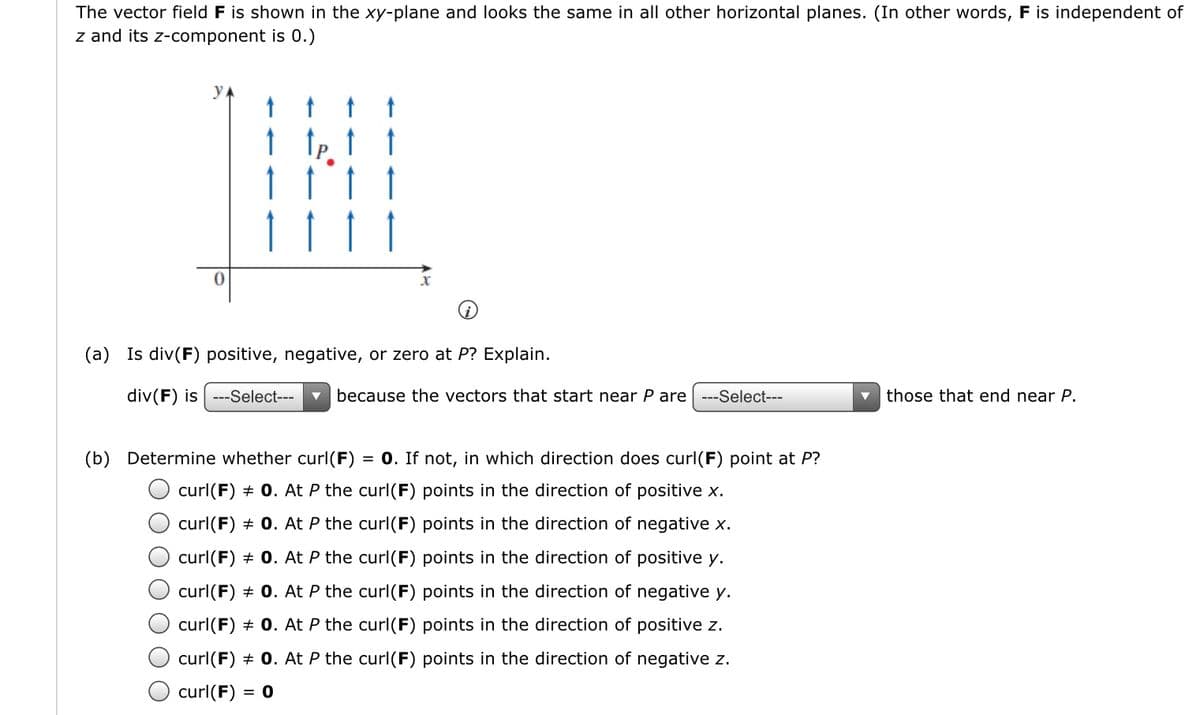The vector field F is shown in the xy-plane and looks the same in all other horizontal planes. (In other words, F is independent z and its z-component is 0.) 1 (a) Is div(F) positive, negative, or zero at P? Explain. div(F) is --Select--- v because the vectors that start near P are --Select--- those that end near P. (h) Determine whetber curICE) - 0 If pot in which direction does curl(E) point at D2
The vector field F is shown in the xy-plane and looks the same in all other horizontal planes. (In other words, F is independent z and its z-component is 0.) 1 (a) Is div(F) positive, negative, or zero at P? Explain. div(F) is --Select--- v because the vectors that start near P are --Select--- those that end near P. (h) Determine whetber curICE) - 0 If pot in which direction does curl(E) point at D2
Algebra and Trigonometry (MindTap Course List)
4th Edition
ISBN:9781305071742
Author:James Stewart, Lothar Redlin, Saleem Watson
Publisher:James Stewart, Lothar Redlin, Saleem Watson
Chapter9: Vectors In Two And Three Dimensions
Section9.FOM: Focus On Modeling: Vectors Fields
Problem 11P
Related questions
Question

Transcribed Image Text:The vector field F is shown in the xy-plane and looks the same in all other horizontal planes. (In other words, F is independent of
z and its z-component is 0.)
(a) Is div(F) positive, negative, or zero at P? Explain.
div(F) is ---Select---
because the vectors that start near P are ---Select---
those that end near P.
(b) Determine whether curl(F) = 0. If not, in which direction does curl(F) point at P?
curl(F) + 0. At P the curl(F) points in the direction of positive x.
curl(F) + 0. At P the curl(F) points in the direction of negative x.
curl(F) + 0. At P the curl(F) points in the direction of positive y.
curl(F) + 0. At P the curl(F) points in the direction of negative y.
curl(F) + 0. At P the curl(F) points in the direction of positive z.
curl(F) + 0. At P the curl(F) points in the direction of negative z.
curl(F) :
= 0
Expert Solution
This question has been solved!
Explore an expertly crafted, step-by-step solution for a thorough understanding of key concepts.
This is a popular solution!
Trending now
This is a popular solution!
Step by step
Solved in 2 steps with 2 images

Recommended textbooks for you

Algebra and Trigonometry (MindTap Course List)
Algebra
ISBN:
9781305071742
Author:
James Stewart, Lothar Redlin, Saleem Watson
Publisher:
Cengage Learning

Elementary Linear Algebra (MindTap Course List)
Algebra
ISBN:
9781305658004
Author:
Ron Larson
Publisher:
Cengage Learning

Algebra and Trigonometry (MindTap Course List)
Algebra
ISBN:
9781305071742
Author:
James Stewart, Lothar Redlin, Saleem Watson
Publisher:
Cengage Learning

Elementary Linear Algebra (MindTap Course List)
Algebra
ISBN:
9781305658004
Author:
Ron Larson
Publisher:
Cengage Learning